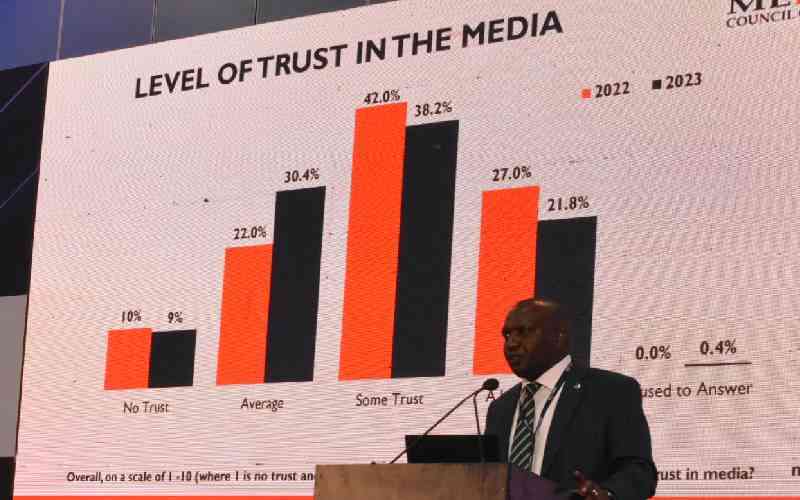
Kenyans still trust mainstream media as their source of information, a new study by the Media Council of Kenya (MCK) reveals.
The study conducted between 2022 to 2023 and released on Thursday at the Annual Media Summit said at least 70 per cent of Kenyans trust media.
The study was done in 47 counties by InfoTrack and released ahead of the 31st World Press Freedom Day to be marked Friday.
The theme of this year's celebration is "A Press for the Planet: Journalism in the Face of Environment's Crisis."
The 70 per cent trust is after a significant proportion of 38 per cent of the surveyed respondents expressed some degree of trust in the media compared to 42 per cent in 2023.
Another 30 per cent reported an average level of trust, up from 22 per cent recorded in 2022.
“This means nine out of 10 Kenyans trust media for information and trust more radio, television, and newspaper for news,” said MCK chief executive David Omwoyo.
The report reveals that television and radio, in that order, remain the preferred main source of news for Kenyans.
About 47 per cent prefer TV with 31 per cent radio followed by 18 and one percent for social media and friends, colleagues and families.
In 2022, newspapers were the fourth source of news after family and friends.
But in 2023, the report says preference for newspapers dropped below online news websites, indicating the continued shrinking of newspaper readership.
The report shows that the majority of Kenyans (75 per cent) watch TV from 7pm to 10pm while 46 per cent watch TV from 8pm to midnight.
For radio, 32 per cent of Kenyans listen in. Social media preference stands at 18 per cent and newspapers six percent.
The report says there are no major changes on trends between the findings of 2022 and 2023.
Another finding is that most Kenyans in 2023 watched TV through a set-top box (either free to air or pay) at 45 percent.
This was followed by digital TV or apps at 24 per cent. Online streaming was at 19 per cent, and satellite cable at 11 per cent.
The report also finds that Kenyans listen more to Swahili radio stations followed by vernacular and a bit of English.
Mostly, Kenyans listen to the radio through the use of FM radio receivers, set-top boxes and online or digital apps and cars, and public vehicles.
According to the survey, the number of people who read newspapers have dropped from 29 per cent to 26 per cent compared to those who watch TV from 71 to 74 per cent.
"This means, three-quarters or seven out of 10 people do not read newspapers while as we saw on TV, at least 7 out of 10 people watch TV," said Omwoyo.
"At least 26 per cent of the surveyed respondents indicated that they read a newspaper in a typical week which is a three percent drop from 2022 which was 29 per cent,” said Omwoyo.
On gender, the report says that more males read newspapers than females at 33 per cent against 18 per cent.
Many newspaper readers still prefer buying hard copy at 37 per cent. This is followed by online subscriptions at 21 per cent.
Reading news on social places is placed at 18 per cent and vendors' selling point at 15 per cent.
Those who read newspapers in offices stood at six percent with some four per cent for those who get it for free.
This was attributed to the shift by newsrooms to e-paper subscriptions and social media impact, which has attracted majority of people especially youths.
News, politics and sports drive readers to buy the newspapers at 33 per cent compared to 45 per cent in 2022.
This is followed by politics at 18 per cent and sports at 12 per cent. Some 48 per cent of Kenyans do not visit websites for news.
On social media as a source of news, WhatsApp, Facebook, YouTube, Tiktok and Instagram lead the pack at 22 per cent, 19 per cent, 14 per cent and 11 per cent, respectively.
Smartphones are also the most used devices for news at 91 per cent followed by smart TV, laptop and mobile handset.
Most Kenyans use WhatsApp digital platforms to access news, the report says.
Facebook and YouTube followed closely at 19 and 22 per cent, and 14 per cent and 11 per cent respectively in 2022 and 2023.
However, the report lists misinformation as one of the concerns.
It emerged that Artificial Intelligence(AI) is the biggest threat, despite only 22 per cent of people in the newsroom admitting to knowing about AI.
Majority at 76 per cent want AI regulated.
Government threats or isolation, poor or lack of pay, digital media onslaught and changing consumer behavior are listed as other media threats.
 The Standard Group Plc is a multi-media organization with investments in media platforms spanning newspaper print
operations, television, radio broadcasting, digital and online services. The Standard Group is recognized as a
leading multi-media house in Kenya with a key influence in matters of national and international interest.
The Standard Group Plc is a multi-media organization with investments in media platforms spanning newspaper print
operations, television, radio broadcasting, digital and online services. The Standard Group is recognized as a
leading multi-media house in Kenya with a key influence in matters of national and international interest.











